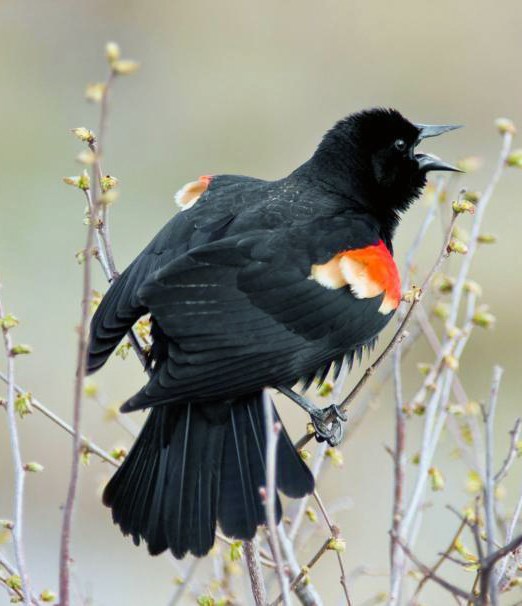Last updated: June 21, 2024
Article
Bird Community Monitoring at Hopewell Culture National Historical Park, 2019

NPS
Why Do We Monitor Birds?
Birds are an important part of the world we live in. They eat pests, disperse seeds, pollinate plants, and feed us, and birdwatching is a multi-billion-dollar industry. Park interpretive programs often feature birds because of the enjoyment they provide. Birds are also great indicators of environmental change. They serve as the canary in the coal mine, so to speak, for an ecosystem. Agriculture and urban development threaten bird habitat in the region around Hopewell Culture National Historical Park. Unfortunately, a significant number of bird species that breed at the park are in decline in the larger regions (41% are in decline in the Eastern Tallgrass Prairie Bird Conservation Region and 58% are in decline in the Appalachian Mountains Bird Conservation Region). Some birds, like the Grasshopper Sparrow, Northern Bobwhite, and Ring-neck Pheasant are declining at alarming rates.
Scientists in the Heartland Inventory and Monitoring Network measure changes in birds and their habitat to determine the health of bird communities and park ecosystems. During the breeding season, we survey birds at Hopewell Culture National Historical Park and gather information about the structure and composition of the park plant communities that birds live in. We also compare park bird trends to bird trends in the larger regions. Together, these data help researchers determine how bird populations are faring and how birds respond to changes in their habitats. Knowing how birds are doing can help the park take effective steps to restore and maintain the park's beautiful landscapes.

Photo by Jeremy Stringfield
Bird Communities at Hopewell Culture National Historical Park (2005–2019)
We have found 112 different bird species in 15 years of surveys. Ninety-eight of these species have the potential to breed within the park, which is about 85% of the total species we would reasonably expect to be breeding here. On average, we found 56 species each year, but the number of species increased over time. One migrant and 14 breeding species on the park are considered species of conservation concern for the Eastern Tallgrass Prairie and/or Appalachian Mountains bird conservation regions. The park is on the border of these two regions.
| Common Name | Scientific Name | AOU Code | Park Resident? |
|---|---|---|---|
| Acadian Flycatcher | Empidonax virescens | ACFL | summer resident |
| Bald Eagle | Haliaeetus leucocephalus | BAEA | summer resident |
| Bewick's Wren | Thryomanes bewickii | BEWR | summer resident |
| Blue-winged Warbler | Vermivora cyanoptera | BWWA | summer resident |
| Cerulean Warbler | Setophaga cerulea | CERW | summer resident |
| Dickcissel | Spiza americana | DICK | summer resident |
| Field Sparrow | Spiza pusilla | FISP | year-round resident |
| Grasshopper Sparrow | Ammodramus savannarum | GRSP | summer resident |
| Henslow's Sparrow | Ammodramus henslowii | HESP | summer resident |
| Northern Flicker | Colaptes auratus | YSFL | year-round resident |
| Prairie Warbler | Setophaga discolor | PRAW | summer resident |
| Prothonotary Warbler | Protonotaria citrea | PROW | summer resident |
| Sedge Wren | Cistothorus platensis | SEWR | migrant |
| Wood Thrush | Hylocichla mustelina | WOTH | summer resident |
| Worm-eating Warbler | Helmitheros vermivorum | WEWA | year-round resident |
Bird Habitat
The park is located in an area that was once forested riparian (streamside/riverside) areas and woodland stands with open grasslands scattered between them. This area has been greatly altered by agriculture and urban development since European settlement. The increasing number of birds at Hopewell Culture National Historical Park suggests that the habitat on the park has improved over time. We will continue to monitor birds and how they respond to changes in their environment to help the park manage habitat for birds. Conserving bird habitat preserves entire ecosystems for the benefit of all species.

NPS

NPS
Trends of Common Bird Species
Nine bird species were common enough for us to measure abundance (how many individuals there were). Abundance measures allow us to look at bird population trends in the park and compare them with trends in the Eastern Tallgrass Prairie and Appalachian Mountains bird conservation regions. Overall, common bird populations in the park are faring as well as or slightly better than in the larger regions.
- Six common species had populations that significantly increased in the park since 2005: Common Yellowthroat, Eastern Meadowlark, Field Sparrow, Indigo Bunting, Northern Cardinal, and Song Sparrow.
- Three common species had stable populations in the park: American Goldfinch, European Starling, and Red-winged Blackbird.

NPS/Nolan Moore
Did You Know?
Northern Bobwhites are uncommon residents at Hopewell Culture National Historical Park. Absent from the state prior to European settlement and open farmlands, the Northern Bobwhite increased its range to include most of Ohio by the late 1800s and early 1900s. Changing agricultural practices and a series of less than favorable winters have restricted the bird to the southern part of the state where it is uncommon now. Improving grassland habitats on the park will help to sustain this species.
For More Information
Read the Full Report.Check back later for updates. We will update this page each year as we gather more information.
Visit the Heartland Inventory & Monitoring Network website.
